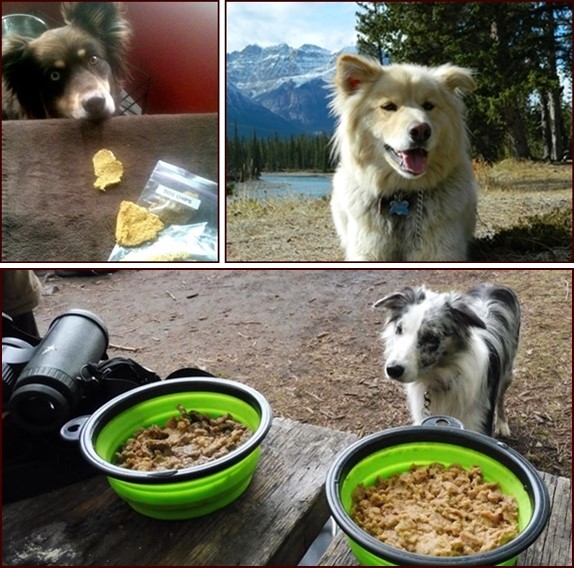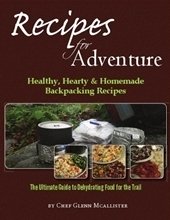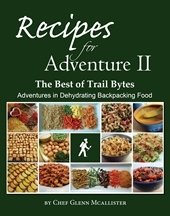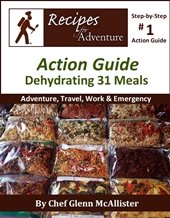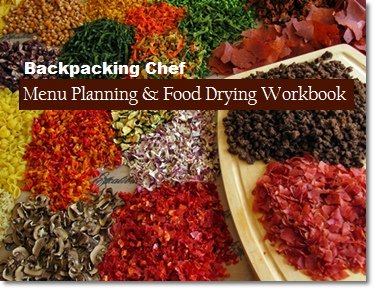Dehydrating Dog Food & Treats
As long as you’re dehydrating people food, why not try dehydrating dog food for your best friend? There will be less weight to carry when you go backpacking, and you can rehydrate the food in a flavorful gravy, or supplement mealtime with homemade dog treats that don’t need rehydrating.
This page is a compilation of recipes, advice, and instructions for dehydrating dog food and treats, which have been shared by the Backpacking Chef Community. You will also find resources for freeze-dried dog food and products to make backpacking with a dog a pleasure. Please use the form at the bottom of the page if you would like to add to the conversation.
People feed their dogs in different ways, just like we choose different diets for ourselves. Some dogs are fed a raw diet of mostly meat, some get home-cooked meats and vegetables, some get canned dog food or dry kibble, and the naughty ones get whatever they steal from the garbage can as soon as you leave the house. While this page demonstrates a variety of approaches that backpackers use for dehydrating dog food, we trust that you are the best judge for what food is best for your dog.
Dehydrating Dog Food Table of Contents
Ingredients for Dehydrating Dog Food
Dehydrating Meat for Dogs
Pork & Vegetables Recipe
Chicken & Rice Recipe (Video)
Dog Bark Stew
Dehydrating Dog Food—Canned
Bacon & Cheese Canine Cookies
Chicken Chips
Liver Treats for Older Dogs
Community Comments

Community Comment: Here is some good advice from Sharon Smith about feeding your dog while hiking. Sharon is studying to become a Canine Nutritionist, and she backpacks and camps often with her dog (above).
"Make sure your dog can tolerate any foods, including treats, you plan to switch to on the trail, or will add to their diet. The last thing you want is a sick pup or a pup that refuses the food!
New foods should be introduced incrementally to your pup’s diet, well in advance of hitting the trail.
Caloric intake requirements will increase, just like with people, when you're backpacking. This doesn't necessarily equate to more food, as simply increasing quantity can make your pup sick; they also may not be able to eat the volume needed. They'll need more, dense, quality nutrients.
If you are home-cooking and dehydrating dog food, make sure you have an AAFCO balanced diet, including appropriate supplements. It may be best to work with a qualified Canine Nutritionist.
Make sure you know exactly how much food your dog will need each day and bring along the appropriate measuring tool. Allocate your dog’s treats to a silicon cup or bag for each day. The night before, add the next day’s treats to the cup. Use those and only those for distributing the treats thru the day. It is very easy to lose track of how many treats you're feeding. Healthy treats have calories too, and humans love giving their pups treats!
Last but certainly not least, make sure your dog has enough clean, fresh, filtered water. Watch their intake! Make sure they are getting enough. They may need more than you expect!" –Sharon Smith
Ingredients for Dehydrating Dog Food
Use plenty of lean meat. The recipes on this page include pork loin, ground beef, chicken, turkey, bacon, and liver.
Combine the meat with dog-friendly vegetables like sweet potatoes, green beans, carrots, corn, broccoli, kale, spinach, zucchini, and pumpkin. Several contributors put apple in dehydrated dog food to help with digestion. Sliced oranges, bananas, and watermelon are also safe for dogs.
Some foods are toxic for dogs:
Don’t use onions, garlic, grapes, raisins, or chocolate when dehydrating dog food. The seeds and pits of fruits should not be fed to dogs. While a small amount of salt is required in a dog’s diet, avoid feeding your dog salty human foods. Dogs love beef jerky, but it’s best to avoid feeding them beef jerky made with sweet and salty marinades. They will like dried jerky just fine without extra flavors. Excessive salt in the foods your dog eats may lead to digestive problems, and will cause your dog to be very thirsty. If water sources are scarce, this could lead to your dog becoming dehydrated.
For more, see: Slideshow: Foods Your Dog Should Never Eat Source: pets.webmd.com.
Should dogs eat cheese? We know dogs love cheese, but moderation is in order. Some dogs, just like some humans, may be lactose intolerant. For more, see: Can Dogs Eat Cheese? Source: akc.org.
Community Comment: There is a great Facebook group called Dehydrated Dog Treats (Recipes and Advice) that will give you all kinds of ideas on homemade dog treats and dehydrating dog food. They recommend freezing uncooked meat for a minimum of seven days to kill potential parasites before dehydrating it raw. –Brooke Richardson
Dehydrating Meat for Dogs
Use lean meat with fat content less than ten percent. Blot off any residual grease with paper towels after cooking meat. The less fat in the meat, the better it will hold up in storage without going rancid. If you want to mix oat flour in with ground meat before cooking it, as you would for yourself to make the meat rehydrate better, that’s o.k.—oat flour in moderation is considered a healthy food for dogs.
Cook meat fully before dehydrating it. Uncooked meat may contain pathogens, such as Salmonella or Trichinella spiralis. Cook ground meat in a frying pan, using minimal oil, until cooked through and no pink color remains.
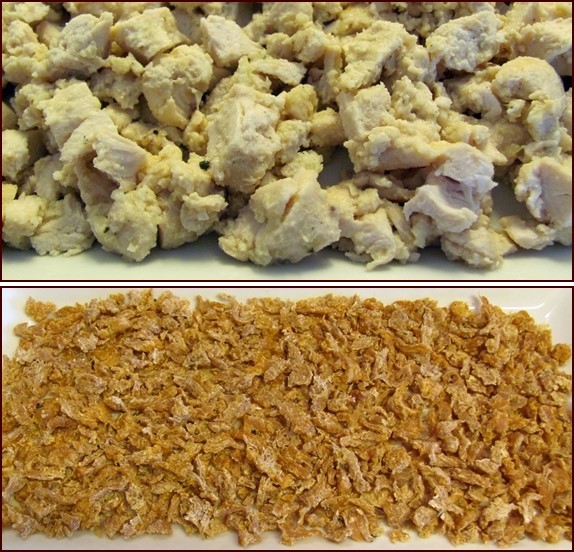
Another method of cooking chicken is pressure-cooking (photo above). See my page on Pressure-Cooking & Dehydrating Chicken.
To cook slices of beef, chicken, or turkey, preheat the oven to 350°F (177°C), and bake the slices in a single layer for ten minutes. After cooking the meat, blot off any fat.
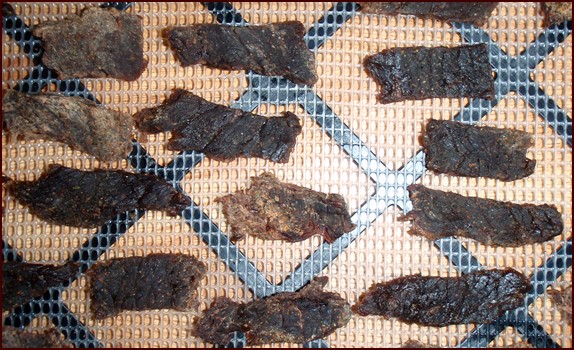
Photo: Beef jerky strips made from a London broil, precooked in the oven and dehydrated. No seasonings or marinades were used.
Dehydrate cooked meat for dogs at 145°F (63°C) up to 155°F (68°C) until meat is hard and dry, inside and out. Although dehydrating times for meat can vary with different dehydrator models and other variables such as humidity, expect a drying time around six hours.
Alternative: Some people dehydrate their meat strips raw, at the highest setting of their dehydrator, between 155°F (68°C) and 165°F (74°C), and then they pop the dried meat in an oven for ten minutes.
Community Comment: I make dehydrated chicken strips for dog treats using boneless, skinless chicken breasts. I partially freeze the meat, slice it about 3/8" thick, and then dehydrate it. I dehydrate them at my highest temperature (155°F/68°C), and typically they finish drying in 8–12 hours. Vacuum seal and store the chicken strips in the freezer. –April R Miller
Chris D'Annunzio adds: I do something similar, but I put them in the oven at 250°F (121°C) for ten minutes after they are done dehydrating, just to make sure I have killed off any lingering bacteria.

Community Comment: I make ground beef jerky strips for our guys (photo above). For every 1 lb. of meat, I add the juice of one lemon as a preservative. I mix it with the KitchenAid paddle attachment, load it in a jerky gun, then into the dehydrator for fifteen hours at 160°F (71°C). Make sure it’s 90/10 fat content. I have not met a dog that doesn’t go crazy for them! In the past I have boiled vegetables, blended them, and added them to the meat for addition nutrition. –Chris D'Annunzio
If your dog is accustomed to eating raw meat, an alternative to cooking and dehydrating dog food is to buy freeze-dried raw dog food, which would not be subjected to high temperatures.
Community Comment: My dogs eat raw, so for the first meal on the trail they will get their raw meat (meat and organs) with a chicken foot. After that, I use freeze-dried raw food. I bring sweet potato, bananas, and apples for their treats. –Ashley Gionet
Community Comment: I only feed my dog a raw meat diet. So unfortunately, the only raw food light enough and stable enough that I've found that is also a complete diet, is freeze dried Primal. It's disgustingly expensive. But we both HAVE to hike. Primal keeps my dog healthy, and my backpack light. I would love to find an alternative that is as healthy, light weight, and with proper calories. For a mid-day snack (treats, and extra calories depending on our itinerary) I bring ZiWi. –Gwen Anderson
Recipes for Dehydrating Dog Food
Pork & Vegetables Meal
Shared by Richard Tofflemire. Trail-tested and approved by Sheldon & Amy.
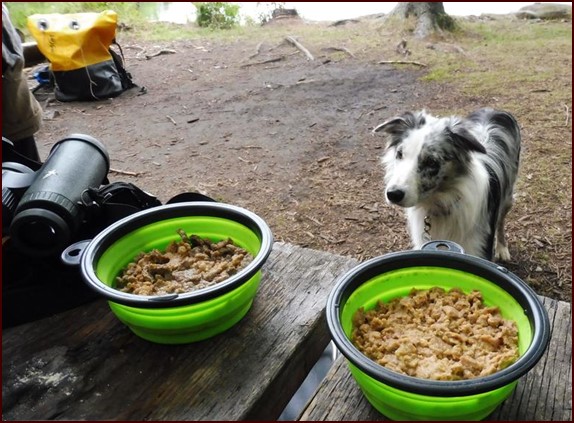
Ingredients:
- 750 g pork loin, cooked
- 470 g mashed potatoes, skin on
- 150 g carrots, raw
- 150 g frozen corn, thawed
- 150 g apple sauce, unsweetened
- 150 g tomato sauce, salt reduced
- 9 g flax seed oil
- 9 g safflower oil
- 37 g honey
We also include a supplement called “Hilary’s Blend.” We get it through our vet, but you can also buy it online (Canada only). The recipe calls for 37 grams of the supplement.
Preparation:
Run the carrots and corn through a blender, mix well with the other ingredients, and spread the mixture on the drying sheets. Use a rolling pin and a top sheet to get it fairly thin.
After dehydrating dog food, break it into pea-sized pieces so it will rehydrate quickly.
This is their main meal. Sheldon get 450 grams per day and Amy gets 300 grams per day. They prefer it rehydrated, but will also eat it dry.
Dehydrating Dog Food Tip: After cooking a recipe for your dog,
divide the food into single-serving sizes that your dog will consume.
Place one serving on each dehydrator tray, and once dried, package in
individual bags.
Dehydrating Dog Food Video
In the video below, Sandra Danen demonstrates her methods for dehydrating dog food. She cooks and dehydrates two homemade dog food recipes—Chicken & Rice and Salmon & Quinoa.
Dog Bark Stew
Chef Glenn’s Method of Dehydrating Dog Food
Ingredients:
- 1¼ lbs. lean ground beef (567 g)*
- ¾ lb. sweet potato (1 large, 340 g)**
- ¼ lb. green beans (1 handful, 113 g)***
* Cooked ground turkey or chicken can be substituted for ground beef.
** Pumpkin or butternut squash can be substituted for sweet potato.
*** Other vegetables may be used in place of, or in addition to, green beans: carrots, corn, broccoli, kale, spinach, and zucchini. An apple can also be included.
Preparation:
Peel and cut sweet potato into chunks and begin boiling in two cups of water.
Trim green beans and cut into smaller pieces. Add to pot with sweet potato when potato chunks are half way to soft.
Continue cooking until sweet potato chunks are soft enough to mash.
Pour off, but retain, the cooking water.
Cook ground beef in a fry pan over medium-high heat until brown.
Tip: If you start off cooking the beef on low with a lid from another pot over the meat, then liquid and fat will lubricate the pan and you will not scorch the meat. Once you have liquid surrounding the beef, turn up the temperature to finish cooking.
When the meat is browned and cooked through, drain off liquid and pat meat dry with paper towels.
Add cooked ground beef to pot with sweet potato and green beans.
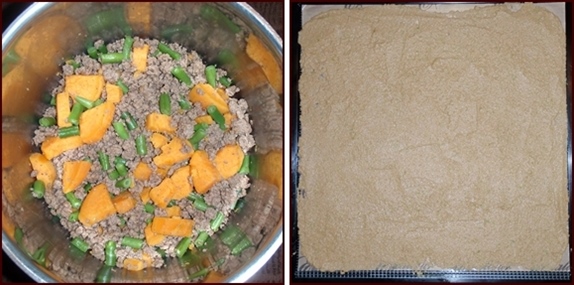
Photos show cooked ingredients before blending (left), and blended ingredients spread on dehydrator tray (right).
Add 1½ cups of the retained cooking water and mash with a potato masher.
Divide mush into two or three parts and run through a blender until smooth.
Spread thinly on dehydrator trays covered with nonstick sheets and dry at 145°F (63°C) for approximately six hours. After four or five hours, flip dog bark over and dry without the nonstick sheets.
Dog Bark is not brittle when dry, so it does not present a choking hazard for dogs. It should feel completely dry and will break into pieces easily.
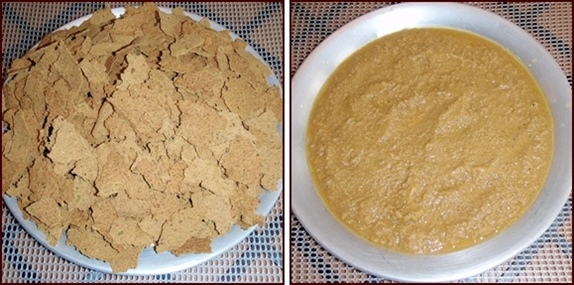
Photos show dehydrated dog bark (left) and a serving of rehydrated dog bark (right).
Dry Yield: This dehydrated dog food recipe yielded four cups of bark weighing seven ounces (200 g). A good serving size that a dog will scarf up in seconds is half-a-cup. Adjust serving size based on your dog’s needs.
Serve dog bark dry, or rehydrate it into a tasty mush with an equal quantity of water. Use dog bark to make Dog Bark Soup with other ingredients your dog will love.
Dog Bark Soup
A delicious soup fit for man and beast. Will help keep your pup well-hydrated. Shown rehydrated below.
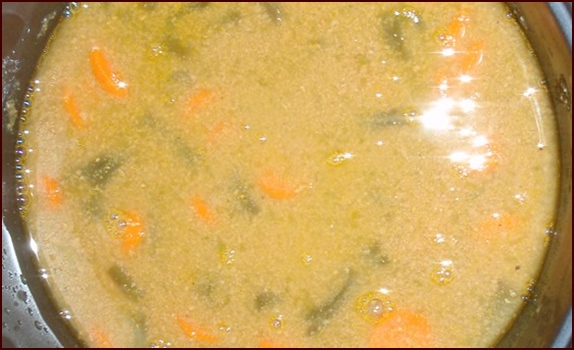
Servings: 1–2
Ingredients:
- 1 cup dog bark (recipe above)
- ¼ cup dried carrots
- ¼ cup dried green beans
- ¼ cup dried ground beef
- 2 cups water to rehydrate
Place all dry ingredients in one Ziploc bag.
On the Trail:
Pour hot water over the food in dog’s bowl and let it sit about twenty minutes. Stir to dissolve bark completely into thin gravy consistency.
Taste test: I fed a serving to Billy Bob, the neighbor’s dog. My neighbor said Billy Bob was not fond of vegetables and usually ate around them if they were ever on his plate. Not this time. Billy Bob cleaned his plate!
Community Comment: I typically bring kibble, but my cooked dog food recipe can be dehydrated. Essentially, I cook ground turkey, mashed sweet potatoes, mashed carrots, green beans, and rice. –David Iannotti
Dehydrating Dog Food—Canned
Can you dehydrate canned dog food? Yes, but…
If your dog is accustomed to eating a favorite brand of canned dog food, you might consider dehydrating it for backpacking.
Warning: It smells awful while it dries.
The main caveat to observe is that canned dog food often has high fat content. Too much fat in dehydrated food increases the risk of the fat turning rancid. Even if the can lists only 5%–6% fat, the actual fat in the solids may be much higher because a lot of added water may be included in the can.
If you want to give it a go, store individual servings in the freezer after drying it, and only use it on shorter backpacking trips. Dehydrated canned dog food may feel greasy, but that will vary by brand. In my experiments, a dog food with pâté consistency was not as greasy as a canned dog food which was less blended.
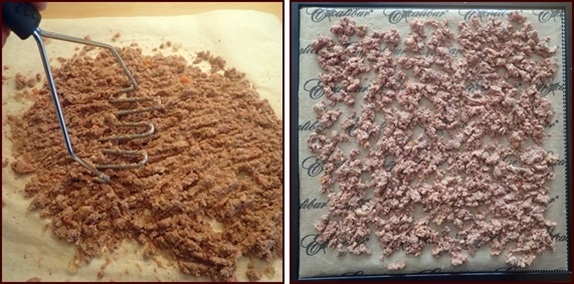
Photos: Mashing canned dog food (left); Mashed dog food spread on dehydrator tray (right).
Step 1: Homogenize the dog food with a potato masher.
Step 2: Spread mashed dog food on dehydrator trays. If the serving size for your dog is one can, then put a whole can on one tray. Otherwise, put smaller amounts on trays to match the serving size for your dog.
Step 3: Dehydrate at 155°F (68°C) until no moisture remains. In my experiments, the dog food with the pâté consistency dried in six hours, and the less blended dog food dried in eight hours.
Step 4: Package individual servings in Ziploc bags and store in freezer.
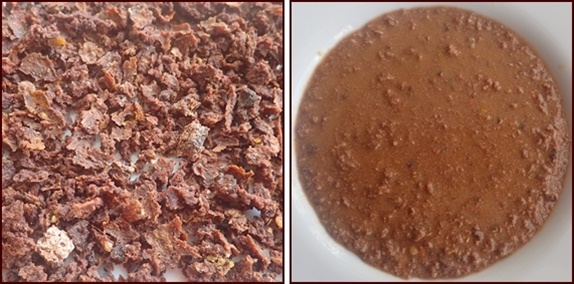
Photos: Dehydrated canned dog food (left); rehydrated on right.
Rehydration: In my experiments, 400 grams of canned dog food weighed 100 grams after dehydrating. That equates to 300 grams of water loss. To rehydrate the dog food to its original moisture content, I added 300 ml (1¼ cups) of hot water. It had a thick gravy-like consistency. Just don’t confuse it with your chili when you and Fido sit down for your meals.
Conclusion: Dehydrating dog food from a can is an option, especially if your dog is used to eating a particular brand. But, if your dog does not eat canned dog food regularly, then you would be better off making and dehydrating homemade dog food using recipes like the ones previously presented, which have plenty of vegetables and meat, but less fat.
Dehydrating Dog Food Storage Tips: Store dehydrated dog food the same way you store dehydrated human food—in airtight containers. Jars with oxygen absorbers are ideal. If dehydrating dog food with high fat content, then store it in the freezer in Ziploc bags until ready to take on a short trip. To make meal preparation on the trail easier, package your dog’s dehydrated meals in individual serving sizes.
Homemade Dog Treats
Bacon & Cheese Canine Cookies
Shared by Richard. Approved by Amy (left) and Sheldon.
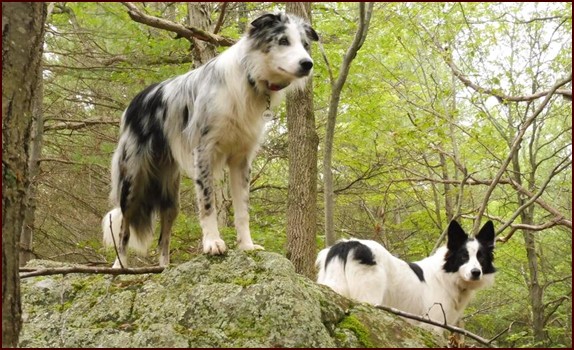
Here is their favorite homemade dog treat recipe; they go bonkers over these. Amy sits in the kitchen waiting while I make them.
Ingredients:
- 1 cup oat flour
- 1 cup brown rice flour
- ½ cup shredded cheese (I use a blend of cheddar, asiago and parmesan)
- 6 slices bacon, cooked and crumbled
- 1 egg
- ¾ cup water
Preparation:
Mix everything together, form into 1” balls, flatten and score them. I score them so they can be broken in half.
Bake at 375°F (190°C) for 30 minutes.
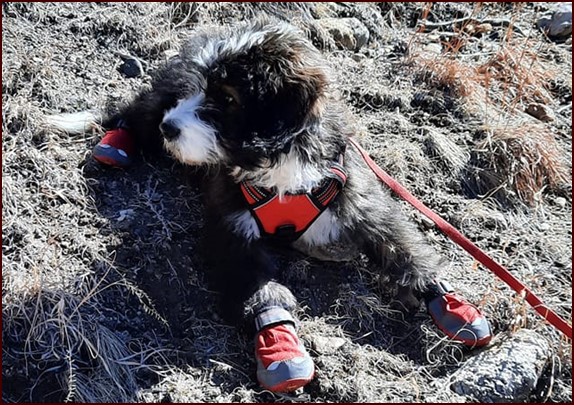
Community Comment: I make homemade dog treats with whole wheat flour, pumpkin puree, peanut butter, and an egg. Little Guy (above) loves them. –Bobbi DeGrazio
Chicken Chips
Shared by AmyLynn
Ingredients:
- 1 package boneless & skinless chicken thighs or breasts
- 2 cups of frozen mixed vegetables (carrots, green beans, peas, etc.)
Preparation:
Cook chicken and vegetables in large pot with enough water to cover ingredients.
After cooking, let cool. Puree in food processor with some of the water in pot. I have found the chips are stronger when not watered down too much, and I use breast or thigh meat, not ground.
Dehydrate like dog bark and break in to chips.
Dog loves them! Chips can go camping as snack or rehydrate back into a gravy for hard dog food.
Community Comment: For treats, I include chicken hearts when I'm making a chicken broth. I slice those cooked hearts and throw them in the dehydrator. My dog loves them. –Sandra Dee Reid
Liver Treats Medicated for Older Dogs
Shared by Holly Bryant
Ingredients:
- 1 lb. liver (chicken, turkey or calf) (454 g)
- 2 Tbsp. oil or grease
- 1 bunch kale
- 2 carrots
- 12-15 glucosamine chondroitin tablets (from Walmart)
Preparation:
Set tablets aside in one cup of warm water. Break them up to hasten their dissolving.
Sauté liver in two tablespoons of bacon grease or other fat until cooked through. Set aside.
Chop up and cook vegetables. I steam them in the microwave.
Mix everything up with food processor or blender. Add extra water to make cookie consistency.
I make cookies out of two tablespoon scoops, lightly flatten with hand. Bake on parchment paper about twelve minutes at 350°F (180°C) until set and lightly browned.
Dehydrate or store in freezer.
Comments from Holly: The supplements the vet sells are way more expensive than glucosamine tablets from Walmart. These are good for older dogs’ joints. I eat them too!
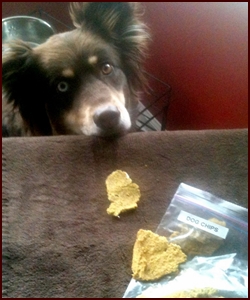
Share a Treat
Do you have a recipe or tips for dehydrating dog food and treats? Or maybe homemade dog treats made in the oven?
Please share your tricks with the Backpacking Chef Community using the form at the bottom of the page.
More Community Comments:
For treats, I carry a variety of homemade dehydrated offal. For meals, I carry homemade powdered stock and store-bought, freeze-dried raw dog food. Too many nutrients are removed when dehydrating dog food with a home dehydrator. I reconstitute freeze-dried raw meat with my homemade stock powder. Make stock as you normally would, let the stock cool overnight, and then remove the fat solids. Try to remove as much fat as possible for a longer shelf life. Remove all solids, and then on a slow boil, boil down to a sticky syrup consistency. Once thick, spread on trays and dehydrate. It looks almost like stained glass when finished. I powder it in a Magic Bullet Blender. –Sally Postlethwaite
We camp all the time but just bring regular kibble. We buy dehydrated beef liver for treats or dehydrate chicken ourselves. –Katrina Zealand
My dog carries all her food. We use dry kibble and regular bone-shaped dog treats (store bought) or homemade peanut butter treats (dehydrated/slow baked), and dehydrated pumpkin purée. Our dog eats less on the move, so these treats are tempting and calorie dense. I’ve dehydrated rice and meat (pressure canned) as well. –Amaris Poznikoff
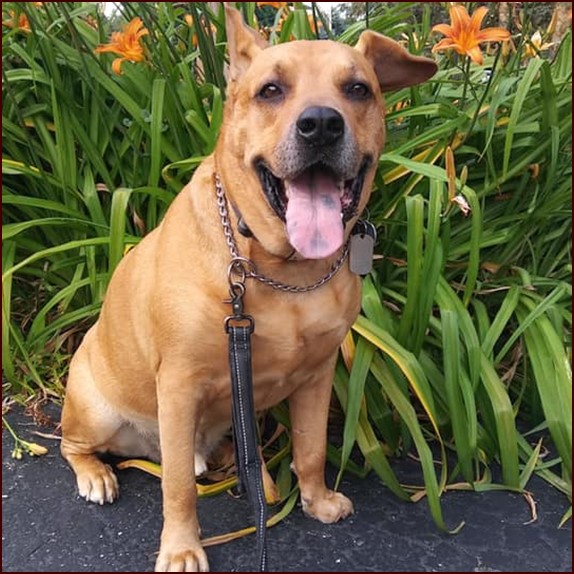
Our Tank (above) is 80 pounds, so he needs lots of food. We bring regular kibble supplemented heavily with freeze-dried food from Stella and Chewy. We rehydrate the freeze-dried stuff, and add it to the kibble. It makes a nice gravy.
We also dehydrate chicken hearts/gizzards; those cheap packs you find in the meat department. We add them to his kibble and serve them as treats. Be careful to not introduce new foods on the trail. –Cindy Lee
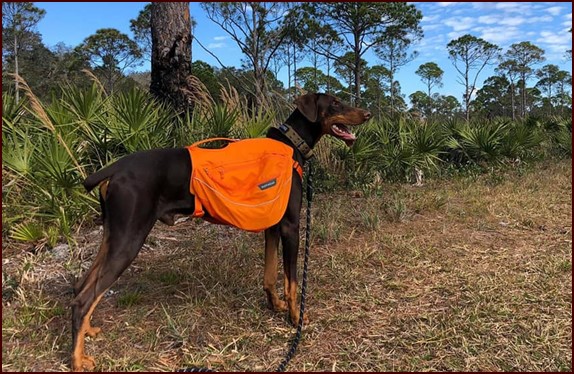
A much more compact and lighter solution for bowls are Outward Hound travel bowls. They fold up and fit in your pocket. For a dog backpack, the quality of Ruffwear is excellent. Rupert (above) carries his own food and water. –David Iannotti
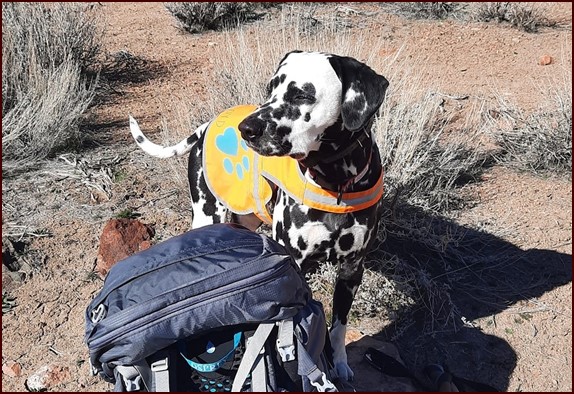
I love hiking with Fearless Floyd (above). We also use Ruffwear packs. –Carol Kwadas Sembach
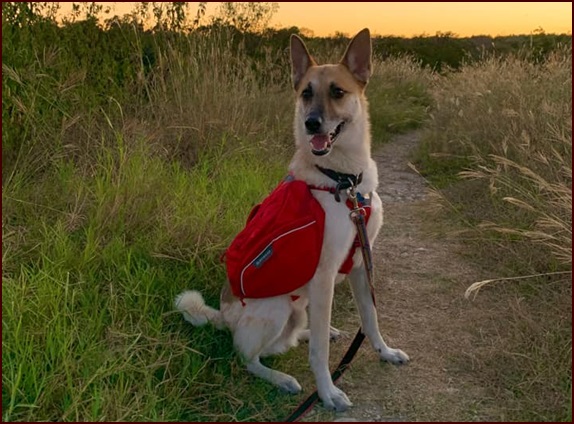
Like at least one other commenter, we also use the Ruffwear pack (above) and Outward Hound collapsible bowl. He carries his water and treats. –Michelle Blank
Find Dog Products on Amazon
Disclosure: Backpacking Chef participates in the Amazon Associates program and earns from qualifying purchases.
Use the form below to share a recipe. If you only want to share a resource or comments about dehydrating dog food, you can just enter them in the ingredients block.
Share this page about dehydrating dog food with your friends on social media.
Free E-book & Newsletter
Free with Trail Bytes subscription.
Dehydrating Food from A–Z

